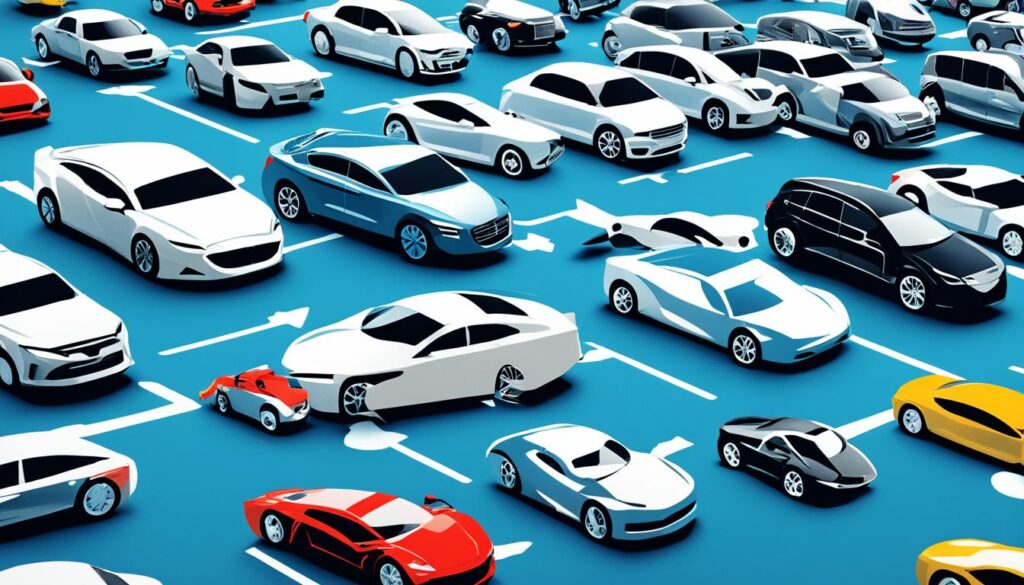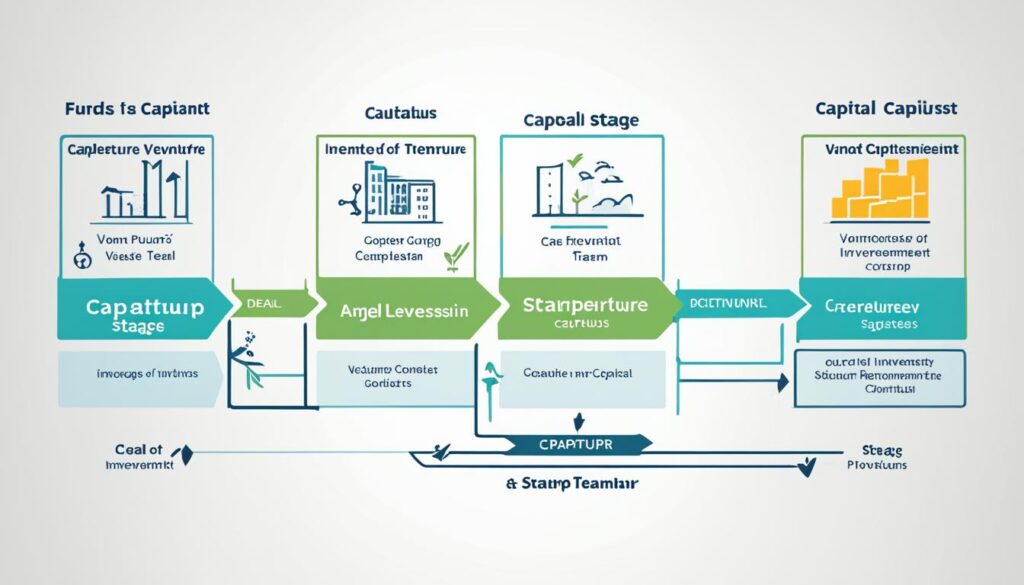When you are building a business, there will come a time when you need to secure funding to grow and expand your business. One popular option is venture capital funding, where investors provide funding in exchange for equity in your company. Venture capital funding is a reliable way to raise your business capital and take it to the next level. With enormous money at play, it’s no surprise that venture capital funding can be pretty intimidating. New business owners are often wary about seeking venture capital, but raising venture capital funding offers a huge scope of opportunities for young businesses.
Key Takeaways:
- Venture capital funding is a way for startups and small businesses to secure growth capital in exchange for equity ownership.
- It can provide not only financing, but also strategic guidance and industry connections from experienced venture capitalists.
- However, venture capital funding also comes with trade-offs, such as dilution of ownership and increased scrutiny from investors.
- Understanding the key aspects of the venture capital industry is crucial for beginners looking to explore this financing option.
- Venture capital can be a powerful tool, but it’s important to separate the myths from the realities of this competitive and risky investment landscape.
Understanding Venture Capital Financing
Venture capital (VC) funding is a form of private equity in which investors provide capital to startups with long-term growth potential. In exchange for the funds, VCs usually take partial ownership and offer their expertise to help the company grow. Unlike traditional loans, venture capital funding involves giving up some control in the company as well as sharing a percentage of future profits with the investors.
What is Venture Capital?
Venture capital is a type of financing that provides capital to businesses, usually in the form of an equity investment. Venture capitalists are professional investors who are willing to take on the risk of funding startup companies with the potential for high growth and returns. They often invest in companies that have innovative products or services, a strong management team, and a clear path to profitability.
When to Consider Venture Capital Funding
Venture capital funding is only suitable for some businesses, but it is popular for startups targeting high-growth opportunities. If you have a business idea that requires significant capital investment and has the potential to make successful returns, venture capital funding is an excellent way to bring your business to new heights. However, as with any investment, venture capital funding carries risks, but with the right preparation and the right investors, you can achieve the goals you have set out for your business.

Pros and Cons of Venture Capital
Securing venture capital funding can be a game-changer for entrepreneurs, but it’s important to weigh the advantages of venture capital against the disadvantages of venture capital before making the leap. Let’s explore the pros and cons of venture capital to determine if it’s the right venture capital funding path for your business.
Advantages of Venture Capital
One of the primary advantages of venture capital is access to a substantial amount of capital that can be used to fuel business growth and development. Venture capitalists are experienced investors who not only provide funding but also offer valuable expertise and networks that can provide mentoring and guidance to help your business succeed. Additionally, partnering with a reputable venture capital firm can lend significant brand and reputation to your startup, opening doors to new opportunities.
Disadvantages of Venture Capital
While the advantages of venture capital are enticing, there are also some notable disadvantages of venture capital to consider. One of the primary drawbacks is the loss of control over your business, as venture capitalists typically take an equity stake in exchange for their investment. This can lead to equity dilution as more investors are brought in over time. Additionally, the high cost of securing venture capital funding, including negotiating deal terms and ongoing reporting requirements, can be a significant burden for some entrepreneurs.
Ultimately, whether venture capital funding is worth it for your business depends on your specific goals, growth plans, and willingness to share ownership and control. By carefully weighing the pros and cons of venture capital, you can make an informed decision that aligns with your long-term vision for your startup.

Key Players in Venture Capital
The venture capital industry is driven by a diverse group of key players who work together to identify, invest in, and nurture promising startups. The main participants in this ecosystem are venture capital firms, general partners (GPs), and limited partners (LPs).
Venture Capital Firms
Venture capital firms are the management companies that conduct the actual business of the venture fund, which is a sum of money or capital used as the primary investment vehicle for investing in startups. These firms play a crucial role in sourcing, evaluating, and selecting the most promising ventures to back with their venture capital funds.
General Partners (GPs)
General partners (GPs) are the partners of the management company who are responsible for raising and managing the venture funds, making investment decisions, and overseeing the venture fund’s operations. GPs leverage their expertise, networks, and strategic guidance to help the startups they invest in achieve their growth objectives.
Limited Partners (LPs)
Limited partners (LPs) are the institutional investors, such as university endowments, pension funds, and high net worth individuals, who provide the capital for the venture fund. LPs entrust their capital to the GPs, who then deploy it into promising startups with the ultimate goal of generating high returns for the LPs.
These key players in the venture capital industry work together seamlessly to identify, invest in, and grow the most promising startups, with the aim of generating substantial returns for all involved.

What is venture capital for beginners?
For beginners, venture capital is a form of private equity financing that provides capital to startups and small businesses with high growth potential in exchange for equity ownership. Venture capitalists are typically experienced investors who not only provide funding but also offer guidance, expertise, and connections to help the companies they invest in succeed. Venture capital funding can be a powerful tool for entrepreneurs looking to scale their businesses, but it also comes with trade-offs such as dilution of ownership and increased scrutiny from investors. Understanding the key aspects of venture capital, including the different types of funds, the deal structure, and the realities of venture investing, is crucial for beginners looking to explore this financing option.
The world of venture capital basics and understanding venture capital can be daunting for new entrepreneurs, but with the right knowledge and preparation, it can be a transformative path for growing a business. By familiarizing themselves with the venture capital landscape, entrepreneurs can navigate this financing option strategically and maximize their chances of securing the capital and support they need to take their venture to new heights.
Venture Capital Fund Structure
At the heart of the venture capital ecosystem lies the venture capital fund, a sum of money or capital that serves as the primary investment vehicle for funding startups. These funds are structured as limited partnerships, governed by partnership agreement contracts typically spanning 7-10 years. The overarching goal of a venture capital fund during this period is to generate returns, either through carried interest on the fund’s performance (around 20%) or management fees (usually around 2%).
Venture Fund
The venture fund itself is distinct from the venture capital management company that oversees its operations. The venture fund is the pool of capital that is deployed into promising startups, often referred to as “dry powder” that is meant to be actively invested. This capital is provided by the fund’s limited partners (LPs), who serve as the institutional investors, such as university endowments, pension funds, and high-net-worth individuals, that supply the necessary funding.
Management Company
The venture capital management company, or VC firm, is the entity that conducts the actual business of the venture fund. It is a separate organization from the fund itself and is responsible for the operational aspects, including raising capital, identifying investment opportunities, evaluating startups, and managing the portfolio. The management company uses the management fees it receives from the fund to cover its overhead and operational expenses related to running the venture firm.

Types of Venture Capital Funds
Venture capital funds develop their portfolio based on a specific investing strategy. There are three main investment fund types that VC firms may structure their portfolio on: types of venture capital funds, venture capital fund strategies, and venture capital fund focus areas.
For example, some venture capital funds may focus on early-stage startups with high-growth potential, while others may invest in more mature companies seeking expansion capital. Similarly, some funds may specialize in specific industries or technologies, such as healthcare or enterprise software, while others may adopt a more diversified approach.
The choice of fund type often reflects the VC firm’s investment thesis, risk appetite, and target returns. Larger funds, for instance, may pursue a broader portfolio to mitigate risk, while smaller, specialized funds may take on more concentrated positions in their areas of expertise.
Regardless of the fund type, venture capital investors typically aim for a gross internal rate of return (IRR) around 30%, as the industry average, to justify the high risk and long-term nature of their investments.

Structuring a Venture Capital Deal
When negotiating a
venture capital deal
, both the startup founders and the VC firm will aim to establish provisions that protect their respective interests. These provisions fall into two broad categories:
Downside Provisions
and
Upside Provisions
.
Downside Provisions
Downside provisions in a venture capital deal are designed to minimize the VC firm’s risk and potential losses. Examples of common downside provisions include:
- Liquidation Preferences – This gives the VC firm priority in receiving their initial investment back, plus a multiple of their investment, before common shareholders can receive any proceeds.
- Anti-Dilution Provisions – These protect the VC firm’s ownership percentage if the company issues new shares at a lower valuation, ensuring their stake does not get diluted.
- Board Control – VCs often demand board representation and voting control to have a say in major company decisions.
Upside Provisions
In contrast, venture capital upside provisions aim to provide the VC firm with the potential for outsized returns if the startup is successful. Upside provisions include:
- Participation Rights – This allows the VC firm to participate in additional distributions of proceeds, even after they’ve recouped their initial investment.
- Conversion Rights – VCs receive the right to convert their preferred shares into common shares to capture a greater share of the upside if the company performs well.
- Redemption Rights – This gives the VC firm the ability to force the company to buy back their shares, providing a way to exit the investment.
Common Provisions
In addition to downside and upside provisions, venture capital deal terms often include other common provisions, such as:
| Provision | Description |
|---|---|
| Information Rights | Requiring the company to provide regular financial and operational updates to the VC firm. |
| Vesting Schedules | Determining how and when the founders’ equity will vest over time. |
| Tag-Along/Drag-Along Rights | Allowing VCs to join in (tag-along) or force founders to join in (drag-along) the sale of the company. |
By understanding these key venture capital deal structures and venture capital deal terms, entrepreneurs can better navigate the negotiation process and structure an agreement that aligns the interests of both the startup and the VC firm.

The Reality of Venture Investing
The venture capital investment reality is that it is a highly competitive and risky landscape. VC firms filter through thousands of deals each year and select the most promising startups to invest in, but the success rate is low. Statistics show that only a small percentage of venture-backed companies actually make it to a successful exit.
Startup Exit Statistics
According to research, less than 1% of startups that receive venture capital investment achieve a successful exit through an IPO or acquisition. This highlights the high-risk nature of venture capital lifecycle, as the majority of venture-backed companies ultimately fail or struggle to generate meaningful returns for their investors.
Venture Capital Lifecycle
The venture capital lifecycle is often misunderstood, with the perception that VCs are risk-takers who pour money into promising ideas. In reality, modern-day venture capitalists are more akin to conservative bankers than the risk-takers of the past. They focus on investing in good industries rather than just good ideas or plans, and a typical VC partner spends less than two hours per week on any given company under their portfolio.
Despite the venture capital investment risks, the role of invention and innovation in driving growth in the U.S. economy cannot be overstated. Understanding the realities of the venture capital industry is crucial for entrepreneurs seeking funding to support their high-growth business ventures.

Venture Capital Myths vs. Realities
The popular mythology surrounding the U.S. venture capital industry derives from a previous era when venture capitalists who nurtured the computer industry in its infancy were legendary for their risk-taking and hands-on operating experience. However, today’s venture capitalists are more like conservative bankers than the risk-takers of days past. They have carved out a specialized niche in the capital markets, filling a void that other institutions cannot serve.
In fact, contrary to the venture capital myths, modern venture capitalists typically achieve high returns by investing in industries that are more forgiving than the market overall. They spend on average less than two hours per week on any given company in a typical portfolio of 10 companies, suggesting that they are more focused on financial engineering than on nurturing innovation.
Despite these venture capital realities, invention and innovation remain significant drivers of the U.S. economy. The venture capital industry, though more conservative than its past incarnation, still plays a crucial role in funding the next generation of disruptive technologies and high-growth startups. The challenge for entrepreneurs is to separate fact from fiction when navigating the complex and often misunderstood world of venture capital.
| Venture Capital Myths | Venture Capital Realities |
|---|---|
| Venture capitalists are risk-takers | Venture capitalists are more like conservative bankers |
| Venture capitalists nurture and support their portfolio companies | Venture capitalists spend less than 2 hours per week on any given company in their portfolio |
| Venture capital funding is essential for innovation and growth | Venture capitalists invest in industries that are more forgiving than the market overall |

Securing Venture Capital as an Entrepreneur
For entrepreneurs seeking to secure venture capital, it’s crucial to first understand the realities of the industry and how it operates. This includes being familiar with the key players, fund structures, deal terms, and the overall landscape of venture investing.
When preparing for venture capital investment, entrepreneurs should develop a comprehensive business plan that clearly outlines their value proposition, market opportunity, competitive advantage, and growth potential. This plan should be accompanied by a well-researched financial model that demonstrates the capital required and the potential for high returns.
In addition, entrepreneurs should tips for entrepreneurs seeking venture capital by networking extensively within the venture capital community, building relationships with potential investors, and understanding the specific criteria and investment thesis of each firm they approach. This will increase the chances of finding the right fit and securing venture capital for their business.
| Key Considerations for Securing Venture Capital | Description |
|---|---|
| Business Plan | A comprehensive plan outlining the business’s value proposition, market opportunity, competitive advantage, and growth potential |
| Financial Model | A well-researched financial model demonstrating the capital required and the potential for high returns |
| Networking | Extensive networking within the venture capital community to build relationships and understand investor criteria |
| Investor Fit | Finding the right venture capital firm whose investment thesis and criteria align with the business’s needs |
By understanding the realities of the venture capital industry and taking the necessary steps to prepare, entrepreneurs can increase their chances of securing venture capital and taking their business to new heights.

Conclusion
As we conclude our exploration of venture capital for beginners, it’s important to remember that the modern venture capital industry is far from the risk-taking, industry-shaping landscape of the past. Today’s venture capitalists are more akin to conservative bankers, carefully selecting industries and startups with the greatest potential for high returns.
While venture capital can still be a powerful tool for entrepreneurs looking to scale their businesses, it’s crucial to understand the realities of the industry. The success rate for venture-backed startups is low, and the venture capital lifecycle can be lengthy and demanding. Entrepreneurs must be prepared to navigate the complex deal structures, provisions, and overall landscape of venture investing to secure the funding they need.
Ultimately, the key takeaways for venture capital for beginners are to approach the industry with a clear understanding of its realities, to have a robust business plan and growth strategy, and to be ready to navigate the often-challenging path to securing venture capital investment. By doing so, entrepreneurs can unlock the vast potential that venture capital funding can offer in scaling their businesses to new heights.
